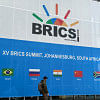Why do some countries trade more than others?

Heoretically, trade liberalisation results in productivity gains through increased competition, efficiency, innovation and acquisition of new technology. In particular, the changing relative prices induced by trade liberalisation cause a re-allocation of resources from less efficient to more efficient uses. Trade liberalisation is also thought to expand the set of economic opportunities by enlarging the market size and increasing knowledge spillover effects. Empirical research on international trade also shows that, in general, larger trade-orientation and freer trade, with supporting policies and institutions, can lead to higher welfare for a country than otherwise.
However, a major question remains some way unclear – why do some countries trade more than others? More specifically, does country size matter? How does difference in per capita income affect trade-orientation among countries? Does human capital make any difference? How does tariff liberalisation promote trade-orientation? Moreover, does foreign direct investment (FDI) affect trade performance? Furthermore, does geographical location have a bearing, i.e., being an island country or a landlocked country? Also, does membership of the GATT/WTO raise trade-orientation? Finally, does institution matter in trade-orientation?
In order to answer these questions, fixed effect panel regressions using a database covering the period between 1981 and 2014 for 128 countries were conducted. We have defined the country's trade to GDP ratio as the country's trade-orientation. We want to explain why some countries have higher trade-GDP ratio than others. The explanatory variables are the size of population (to represent country size), per capita real GDP, an index of human capital, domestic average applied tariff rate, and FDI to GDP ratio. Data for all these variables, except human capital, are taken from the World Bank's WDI, and the data of the human capital is taken from the PWT-8.1. All variables are expressed in natural logarithm. The regression results show that all explanatory variables are statistically significant.
The negative coefficient estimate of the size of population reveals that larger countries tend to be less trade-oriented than their counterparts, as 1 percent rise in the size of the population is associated with 0.2 percent fall in the trade-GDP ratio. The reason is that countries with a large population find a ready domestic market and can substitute imports by producing for the internal market. The positive coefficient of the per capita GDP shows that a rise in the real GDP per capita by 10 percent is associated with a rise in the trade-GDP ratio by 2.2 percent. The reason behind such an association could be related to domestic producers, with the rise in per capita GDP, becoming more efficient in competing and integrating with their foreign counterparts in the world market. As expected, domestic tariff liberalisation is positively associated with higher trade-GDP ratio, as a cut in tariff rate by 10 percent is associated with a rise in trade-GDP ratio by 0.7 percent.
The positive coefficient of the FDI-GDP ratio suggests that greater FDI orientation is positively associated with greater trade orientation, and a rise in the FDI-GDP ratio by 10 percent is positively associated with a rise in the trade-GDP ratio by 0.3 percent. FDI is assumed to have a positive impact on the export-orientation of any economy, as much of FDI is directed towards the export-oriented sectors. The success stories of East and South East Asian countries have suggested that FDI is a powerful tool of export promotion because multinational companies, through which most FDI is undertaken, have established-contacts and up-to-date information about foreign markets. FDI may also lead to increasing imports in the recipient country as foreign owners tend to have a higher propensity to obtain their inputs from abroad than do their domestically owned counterparts.
Finally, in the case of human capital variable, a rise in the index of human capital by 10 percent is associated with a rise in the trade-GDP ratio by 9 percent. This is not surprising! A higher level of human capital is likely to have a positive impact on the perception of the people, as well as on the policy making of the government, in integrating their economy with the world market.
The findings of the LSDV models show that landlocked countries and island countries are 194 percent and 284 percent respectively more trade oriented than their counterparts. Both for island and landlocked countries, international trade plays a crucial role in their economic lives as most of these countries are dependent, to an unusual degree, on imported goods and services, including foodstuffs, fuel, equipment and industrial material as well as a wide range of manufactured products. However, interestingly, being a member of the GATT/WTO doesn't make any difference in terms of trade-orientation.
We have also explored the association between trade-orientation and different institutional variables. The data of these institutional variables are derived from the ICRG database. The fixed effect regression results suggest that countries with better bureaucracy quality, larger democratic accountability, and sounder investment profile are associated with higher trade-orientation. These results are also consistent with findings from studies on the determinants of trade flows which argue distortions or costs placed on firms under inefficient institutions and poor governance can negatively affect trade flows.
Bangladesh's trade-GDP ratio was only 19.2 percent in 1981, which increased to 44.5 percent by 2014. Despite the fact that Bangladesh has been able to raise its trade-GDP ratio by more than two-folds during this period, in 2014, out of the 166 countries, Bangladesh ranked 150th in terms of higher trade-GDP ratio. This suggests that greater trade-orientation in Bangladesh would require further cut in tariff rates, larger FDI-orientation, investment in human capital and improvement in institutional quality.
The writer is Professor, Department of Economics, University of Dhaka, Bangladesh, and Executive Director, South Asian Network on Economic Modeling (SANEM).
Email: [email protected].

 For all latest news, follow The Daily Star's Google News channel.
For all latest news, follow The Daily Star's Google News channel. 








Comments